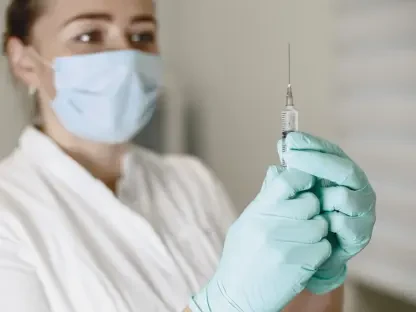What happens when a critical lifeline for understaffed hospitals turns into an insurmountable financial barrier? A staggering $100,000 fee for new H-1B visa applications, implemented under recent policy changes, has sent shockwaves through the U.S. healthcare system, leaving hospitals already battling severe staffing shortages to face a daunting challenge in maintaining care standards while grappling with costs that could cripple their budgets. This dramatic shift raises urgent questions about patient access to care, staff burnout, and the future of medical innovation in a nation heavily reliant on international talent.
Why This Policy Shift Matters
The significance of this fee hike cannot be overstated for an industry teetering on the edge of a workforce crisis. With projections from the Health Resources and Services Administration indicating a shortfall of over 187,000 physicians by 2037, and a 6-13% nurse deficit in the same timeframe, foreign-born professionals have become indispensable. The H-1B visa program, a key pathway for recruiting such talent, now risks becoming inaccessible due to costs that many providers, especially in rural areas, simply cannot afford. This policy threatens not just hospital operations but the very fabric of healthcare delivery across underserved communities.
The Backbone of Healthcare Under Strain
Delving deeper, the H-1B program has been a cornerstone for addressing gaps in specialized roles since its inception in 1990. Though only a fraction of the workforce—8,492 of 141,205 new visas in the latest fiscal year went to healthcare workers—their impact is profound. These professionals often fill positions in remote regions where domestic candidates are scarce, ensuring that critical services remain available. The new fee structure, jumping from a previous maximum of $5,000 to $100,000, alongside a lottery system prioritizing higher-wage earners, could sever this vital pipeline at a time when every clinician counts.
Hospitals, particularly smaller facilities with tight budgets, stand to lose the most. The financial burden of shelling out such an exorbitant amount per hire forces a grim choice: halt recruitment, overburden existing staff, or cut services altogether. In rural Missouri, for instance, a hospital reliant on international nurses for 30% of its staff faces the real possibility of reduced care capacity if this talent pool dries up, directly impacting patients who already struggle with access.
Financial and Operational Fallout
The ripple effects of this policy touch every corner of healthcare systems. Financially, the $100,000 fee per new H-1B hire is a knockout blow for community clinics and rural hospitals operating on razor-thin margins. Many may turn to expensive travel nurses as a stopgap, further straining budgets, or risk closure of entire departments. This economic pressure could reshape the landscape of care delivery, especially in areas already classified as medically underserved by federal standards.
Operationally, the absence of international workers exacerbates an already dire staffing crisis. Beyond numbers, these clinicians often bring seasoned expertise, mentoring newer staff and easing workload pressures. Without their stabilizing presence, turnover rates—already at 30% for first-year nurses due to stress and workplace challenges—could skyrocket. Patient safety hangs in the balance as overworked teams struggle to maintain quality under mounting strain, painting a troubling picture for healthcare resilience.
Voices from the Ground
Healthcare professionals and leaders are sounding the alarm over the potential devastation this fee hike could unleash. Jimmy Lai, CEO of a prominent law firm specializing in immigration, has warned of “seven- or eight-figure liabilities” for providers unable to absorb these costs. Similarly, immigration attorney John Dawson highlights that most hospitals lack the financial cushion to navigate this barrier, predicting a sharp decline in international hires.
On the front lines, the human toll is palpable. An anonymous Filipino nurse working in a rural hospital shared that her facility depends on international staff to keep operations afloat, warning that reduced recruitment would intensify burnout and compromise patient care. Kara Murphy, president of a healthcare staffing firm, emphasized the role of these workers as preceptors in high-stress units like ICUs, noting their absence could destabilize entire teams and hinder retention of domestic graduates.
In the tech sphere, which intersects heavily with healthcare innovation, Sujay Saha, a former H-1B holder turned industry leader, cautioned that losing global talent—65% of visa holders work in technology—could stall advancements in medical devices and AI. This brain drain might push companies to relocate R&D abroad, dulling the competitive edge of U.S. healthcare on the global stage.
Strategies to Weather the Storm
Amid this uncertainty, healthcare providers are exploring ways to adapt to the harsh realities of the new visa landscape. Advocacy for exemptions remains a top priority, with organizations like the American Hospital Association pressing for “national interest” waivers to shield critical healthcare roles from the fee, especially in underserved regions. Collaborative efforts to influence policy could be a lifeline for struggling facilities.
Internally, retention of current staff, both international and domestic, is gaining focus. Programs targeting burnout prevention and mentorship can help stabilize workforces, reducing dependency on new hires. Additionally, exploring alternative visa pathways, such as J-1 or TN categories, offers a potential workaround, though these come with their own constraints and complexities.
Technology also presents a partial solution, with telehealth and automation poised to offset staffing gaps. While not a complete fix, accelerating adoption of these tools can sustain care delivery in the short term. Lastly, staying abreast of legal challenges to the fee’s implementation is crucial, as ongoing lawsuits may yield relief or reshape hiring policies, providing a glimmer of hope for the sector.
Reflecting on a Critical Juncture
Looking back, the imposition of a $100,000 fee for new H-1B visa applications stood as a pivotal moment that tested the resilience of the U.S. healthcare system. The policy, while aimed at prioritizing American workers, sparked unintended consequences that threatened patient care, staff well-being, and medical innovation. As the industry grappled with these challenges, the path forward demanded strategic action. Providers needed to unite in pushing for policy exemptions, invest in workforce retention, and leverage technology to bridge gaps. Monitoring legal outcomes remained essential, as did a renewed focus on long-term solutions to domestic staffing shortages. This crisis underscored the urgency of balancing immigration reforms with the unique needs of a sector vital to national health, urging stakeholders to act decisively to safeguard care for all.









